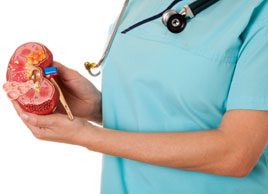What causes kidney stones?
Kidney stones definitely aren’t fun, but there are ways to prevent and treat them. Read on to find out how

Source: Best Health Magazine, September 2012
This could be painful: 10 percent of men will develop kidney stones over their lifetime, and most get them between ages 30 and 50. (About five to seven percent of women develop stones over the course of their lives.) These hard mineral formations can sometimes be detected early by chance, before they become painful, on an ultrasound or other imaging test performed for another reason. More often, they are found because they block the flow of urine from the kidneys and cause sudden, debilitating pain in the low back and side.
‘Most people say it’s the most intense pain they’ve ever experienced,’ says Dr. Hassan Razvi, professor and chair of the division of urology at the Schulich School of Medicine & Dentistry at The University of Western Ontario.
What causes them?
The risk is highest in people who are chronically dehydrated (often from not drinking enough fluids or consuming only caffeinated drinks, but also due to working in hot environments, which increases hydration needs) and those who are overweight, eat a salty diet, consume excess protein, or have diabetes or other metabolic conditions such as certain kidney diseases or overactive parathyroid glands. A 2009 study from Harvard Medical School found that people who ate lots of vegetables and whole grains and few processed meats’a healthy diet prescribed for people with high blood pressure’were up to 45 percent less likely to develop stones.
When a patient complains of flank pain and the doctor suspects a stone, an ultrasound or CT scan will be ordered. If the test shows the stone is smaller than six millimetres, the patient will be sent home with painkillers and instructions to drink lots of water and take an alpha-blocker (a medication for treating enlarged prostate symptoms that Razvi says has also been shown to help stones pass faster). Good news: Contrary to popular belief, when you do finally pass a stone that is six millimetres or less, it is virtually painless (and some people don’t even know they’ve done it), as the urethra in both men and women is large enough to handle small stones.
Medical treatments
Larger stones, or those that do not pass spontaneously, may require treatment such as shock wave therapy, which is a minimally invasive outpatient procedure. The patient is treated with intravenous sedation anesthesia while shock waves are pulsed through the abdomen to break the stones into small pieces. Other interventions include minimally invasive endoscopic surgery.
Since 50-75 percent of people with stones may get them again unless the risk factors are corrected, preventive measures are an important strategy. After a stone has been passed, it will be analyzed. If it’s found to be made of calcium oxalate (the most common type), the patient will be counselled to increase fluid intake, normalize calcium intake, and reduce sodium, protein and oxalate consumption. (Oxalate is an undigestible substance present in many foods including healthy ones, such as spinach, most nuts, strawberries and teas.)
For the majority of patients who make the necessary dietary changes, their risk of further stones can be greatly reduced. In certain cases, medications may be required to manage specific metabolic conditions that diet alone cannot correct. And remember, prevention is important: Having had kidney stones increases your risk for kidney disease, and a 2010 Mayo Clinic study linked having at least one incidence to a 38 percent higher risk of heart attack.
This article was originally titled "Stones got him down?" in the September 2012 issue of Best Health. Subscribe today to get the full Best Health experience’and never miss an issue!




